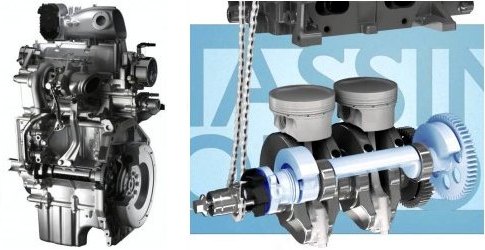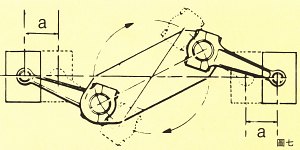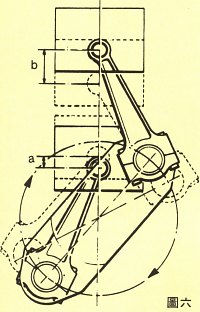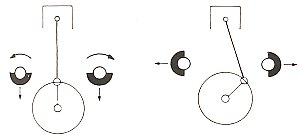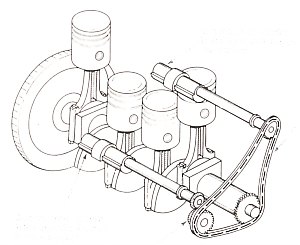|
AUTOZINE TECHNICAL SCHOOL
Engine Configuration and Smoothness Introduction and Basic Theory A refined engine should be smooth running,
free of vibration and quiet. These qualities also help the engine to
spin freer at high rpm, lifting red line hence power output.
Engine smoothness depends very much on the basic configuration of the engine design, i.e. the number of cylinders, how the cylinders are arranged (in-line, V-shape or horizontally opposed) and the V-angle for V-shape engines. In case a less favourable configuration is chosen, probably due to packaging or cost reasons, counter weights or balancer shafts may be used to counter the vibration generated at the price of a little bit energy loss. Strengthening the engine block, crankshaft etc. can absorb certain level of vibration and noise. Lastly, the use of low-friction parts may enhance smoothness and quietness further. Smooth power delivery A cylinder takes 720° crankshaft angle (i.e., 2 revolutions) to complete 1 cycle of 4-stroke operation. In other words, it fires once every 2 crankshaft revolutions. Only the power stroke (expansion stroke) generates positive power, while intake stroke, exhaust stroke and compression stroke consume power, especially the latter. As a result, a single-cylinder engine generates power in the form of periodic pulses. The picture below shows how the power is delivered: 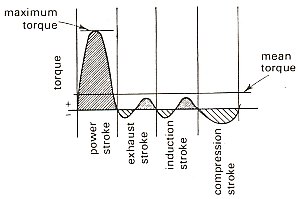 To smooth the power delivery, all engines must employ a heavy flywheel, using its inertia to keep the engine running roughly at constant speed. Of course, the heavier the flywheel, the smoother the power delivery becomes, but it also makes the engine less responsive to throttle. With a reasonably large flywheel, the pulsation manner of power delivery cannot be completely rectified. Therefore, we need multi-cylinder engines. While a single-cylinder engine fires once every 2 revolutions, twin-cylinder engine fires once every revolution, 3-cylinder fires once every 720 / 3 = 240° crank angle, 4-cylinder fires once every 180° (half a revolution).... 12-cylinder engine fires once every just 60° crank angle. Obviously, the more cylinders the engine has, the smoother the power delivery becomes. This explains why we prefer V12 engines to inline-6s, although both of them achieve near perfect internal balance. Cause of vibration Vibration is caused by the movement of the internal parts, especially pistons and connecting rods. The pistons and con-rods move up and down periodically without counter-balanced by other means. If the engine is a single-cylinder engine, it will jump up and down periodically as well. In reality, the direction of vibration is not just vertical. Because the connecting rods are not just travelling upward and downward, but also leftward and rightward, there are also some vibrations in transverse direction. However, compare with pistons, connecting rods are much lighter, thus the vibration generated by the left and right movement of con-rods is also much smaller than the up and down vibration caused by the pistons. What about multi-cylinder engines? That's much more complicated than imagined. We'd better to discuss case by case. Inline-2 As the engine fires once every revolution (or 720° / 2 = 360° crankshaft angle), the two pistons run exactly in the same direction as well as position. This means the net vibration will be twice the magnitude of that generated by one cylinder. The direction of vibration is mostly upward / downward. This is the worse engine configuration for refinement, therefore it used to be employed by the cheapest mini cars, such as Fiat 128, Cinquecento, Tata Nano and some older Japanese K-cars. However, under the pressure to cut CO2 emission, Fiat resurrected the idea in 2010 with the advanced TwinAir engine. The 875 c.c. unit employs electrohydraulic valve control and turbocharging to compensate for its lack of capacity. Its reduced moving components and surface area cut frictional and thermal losses, resulting in a claimed 30 percent reduction of fuel consumption. Meanwhile, refinement is taken care by a counter-rotating balancer shaft located adjacent to the crankshaft, which cancels the first order vibration, if not second order vibration (i.e. the vibration at twice the frequency of crank speed). Nevertheless, the strong pulsation effect in exhaust note remains an enemy to accoustic refinement.
Inline-3 As the engine fires once every 240° crankshaft angle (720° / 3 = 240°), the crankshaft design is as shown below. Firing order is 1-3-2. 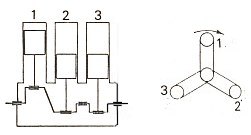 It seems that no matter
how the crankshaft rotate, the combined center of gravity of all 3
pistons and con-rods remains at the same position, hence no vibration
generated. By mathematical analysis, you can also find no forces
generated in both vertical and lateral direction. (I really performed
such calculations) So why did we hear that 3-cylinder engine needs a
balancer shaft? It seems that no matter
how the crankshaft rotate, the combined center of gravity of all 3
pistons and con-rods remains at the same position, hence no vibration
generated. By mathematical analysis, you can also find no forces
generated in both vertical and lateral direction. (I really performed
such calculations) So why did we hear that 3-cylinder engine needs a
balancer shaft?In fact, the calculation is wrong because it assumes the engine as one point, thus the forces of all 3 cylinders act on this single point and result in complete cancellation. In reality, the forces act on 3 different positions on the crankshaft, thus instead of canceling one another, they make the crankshaft vibrating end to end. Don’t understand? Look at the picture above, the side view of the engine. Piston 1 is at the top now and is going downward, thus generates an upward force to the left end of the crankshaft. Piston 2 is also going downward, thus generates an upward force to the middle of the crankshaft. Piston 3 is going upward, thus generates a downward force to the right end of crankshaft. As the engine’s center of gravity locates at cylinder 2, you can see forces from piston 1 push the left end of the engine upward while forces from piston 3 push the right end of the engine downward; After 180° rotation, the situation is completely reversed - downward force at left and upward force at the right. In other words, this is an end-to-end vibration with respect to the engine center at cylinder 2. 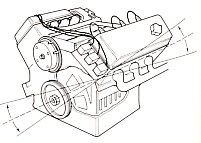 End-to-end
vibration (shown here is a V6) End-to-end
vibration (shown here is a V6)Solution - single balancer shaft Therefore, most inline-3 engines are equipped with a balancer shaft. The crankshaft-driven balancer shaft has a weight at each of its end. The weights move in direction opposite to the direction of the end pistons. When the piston goes up, the weight goes down. When the piston goes down, the weight goes up. As a result, the end-to-end vibration can be cancelled by the balancer shaft which is driven at the same speed as the crankshaft. It goes without saying the balancer shaft adds cost, weight and friction, which offsets part of the efficiency gain of the 3-cylinder engine. Ford 1.0 Ecoboost engine cleverly avoided balancer shaft by using an unbalanced flywheel and pulley to shift the first order vibration from vertical to transverse orientation, which is easier to be absorbed by better engine mounts and clutch damper. The result is remarkable refinement. Inline-4 As commonly known, large inline-4 engines need twin-balancer shafts rotating at twice the speed as the crankshaft to reduce vibration. This is very different to 3-cylinder engines, which need a single balancer shaft running at crankshaft speed. Obviously, the vibration generated by inline-four engines is not the same as that of 3-cylinder engines. I did some research into this topic by mathematical analysis, also wrote a program to simulate the vibration. The result is exactly the same as found in any textbooks. However, to explain to you in simpler language, let us see in this way: 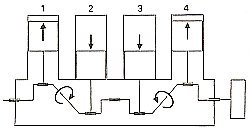 This picture shows an
inline-4 engine. It fires once every 720° / 4 = 180° crank
angle, thus 2 of the pistons are in exactly the same position and move
in the same direction, while the remaining 2 pistons are also a pair.
To avoid the end-to-end vibration as experienced in 3-cylinder engines,
car makers always arrange the pistons as shown in the picture, that is,
in symmetric form. In other words, piston 1 and 4 are a pair, while
piston 2 and 3 form another pair. Therefore the movement of piston 1 is
always balanced by the symmetric piston 4. The same goes for piston 2
and 3. This picture shows an
inline-4 engine. It fires once every 720° / 4 = 180° crank
angle, thus 2 of the pistons are in exactly the same position and move
in the same direction, while the remaining 2 pistons are also a pair.
To avoid the end-to-end vibration as experienced in 3-cylinder engines,
car makers always arrange the pistons as shown in the picture, that is,
in symmetric form. In other words, piston 1 and 4 are a pair, while
piston 2 and 3 form another pair. Therefore the movement of piston 1 is
always balanced by the symmetric piston 4. The same goes for piston 2
and 3.That’s just the end-to-end vibration with respect to the engine center. What about the resultant upward / downward vibration? It seems that the movement of piston 1 is counter-balanced by piston 2, while piston 3 counters piston 4. However, this observation is just skin-deep. More professional speaking, that observation covers just the balance of 1st order force. The second order force (which can be derived from equation) is normally much smaller than the 1st order force, and it is rotating at twice the frequency of the 1st order force. Nevertheless, the configuration of inline-4 actually multiplies the magnitude of 2nd order force thus making it hard to be ignored, especially for larger engines. A simpler explanation is given in the pictures below, which compare a perfectly balanced boxer-4 engine with an inline-4 engine.
As seen, no matter at what crankshaft angle, the boxer engine has the pair of pistons always in opposite positions, directions and speeds, thus all the forces can be balanced. (If not for packaging and cost reasons, boxer engines would have been the best choice) In contrast, in a straight-four engine, if you rotate the crankshaft by a certain angle, the piston near the top end will displace by distance (b), while another piston near the bottom will displace distance (a). Note that (b) is larger than (a). Moreover, the longer the crank throw, hence cylinder stroke, the larger the difference. As vertical force is the product of displacement and mass of piston and divided by the time taken for such displacement, you can see the different displacements must lead to different forces, therefore complete cancellation is impossible. The resultant force is the aforementioned second order force, which rotates at twice the speed of the crankshaft. Solution - Twin-balancer shafts Therefore, the longer the stroke, or the heavier the pistons and con-rods, the more second order vibration generates. Unfortunately, car makers favour straight-four engines for advantages of low costs and compact size. Since the 1980s, car engineers regarded 4-pot engines larger than 2 litres in capacity had better to be equipped with twin-balancer shafts to cancel the vibration. Although the strengthening of engine block, the use of hydraulic engine mounts and lightweight pistons helped breaking such rules, the trend of pursuing refinement once again drove many engines larger than 2 litres to use balancer shafts. Balancer shaft was invented by British automotive engineering maestro Dr. Frederick Lanchester in the early 20th century. Mitsubishi obtained the patent and put it into mass production in the 1976 Colt Celeste 2000, then Fiat group used it in its Lamda engine series, including the 1.6-litre on Delta HF turbo and 2-litre turbo unit on Fiat Croma and Lancia Thema. Meanwhile, Saab 9000 and Porsche 944 also introduced it into their powerful inline fours. All these car makers obtained licenses from Mitsubishi.
To deal with second order vibration, a pair of balancer shafts is needed. They are driven by the crankshaft and rotate in directions opposite to each other, at twice the speed of the crankshaft. Normally they locate in either sides of the engine, one of them just above the crankshaft level while another is far above. More recently, some engines put the balancer shafts in the sump to save space. Counter weights on the balancer shafts completely cancel the second order forces, result in a silky-smooth rotation. The use of 2 balancer shafts instead of a large single one is because the vibration generated by the engine is mostly in vertical direction. 2 shafts rotating in opposite direction can cancel each other’s transverse force and result in a net vertical force which is used to balance the vibration. Without twin-balancer shafts, Porsche would have been impossible to make the 3-litre inline-four which powered the 944 S2 and 968. That was the largest four-cylinder engine used in modern cars. Inline-5 Straight-five engines are not very popular on the market. In the past 30 years, only Audi, Volkswagen, Volvo, Honda (Vigor), Fiat group (2.0 and 2.4-litre Super Fire series) and Mercedes diesel adopted this configuration. However, straight-five engine has its own advantages. Firstly, it bridges the gap between 4 and 6-cylinder engines, thus may offer the best cylinder capacity for optimized efficiency; Secondly, compared with 4-cylinder engines, it saves one balancer shaft; Thirdly, compared with 6-cylinder engines, it is short enough to be fitted transversely into the engine compartment of front-wheel-drive cars, driving directly the tranverse gearbox. Lastly, it can be derived from a modular design consisting of 4 and 6-cylinder inline engines, saving not only development costs but the investment of a new production line. Fiat, Mercedes and Volvo’s 5-pots, for example, were made as modular families. The inline-5 engine fires once every 720° / 5 = 144° crank angle. As a result, the crankshaft design is as shown below. Firing order is 1-3-5-4-2. 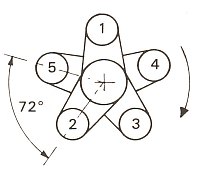 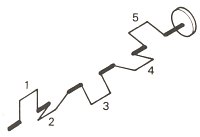 My mathematical analysis proved that both its resultant first order force and second order force are balanced. Therefore it doesn’t need the twin-balancer shafts as in the case of a big 4-cylinder engine. However, it generates end-to-end vibration like 3-cylinder engines, because piston 1 is not in the same position as piston 5, and piston 2 is not in the same position as piston 4. Therefore both ends of the engine will vibrate up and down with respect to the engine center. Solution - single balancer shaft Obviously, the solution is the same as 3-pot engines, that is, employs a balancer shaft on which there are counter weights moving in the opposite direction to the pistons. The balancer shaft is driven by the engine at the same speed as the crankshaft. Is that enough to make 5-cylinder engine as smooth as 6-cylinder? No. For packaging reasons, the balancer shaft cannot be placed in the most optimized position, that is, right above or below the crankshaft. Therefore it has to be offset to either side of the engine, resulting in incomplete cancellation of vibration. However, in practice the inline-5 engines on the market are smooth enough to beat 4-cylinder engines, and their exhaust note sound better as well. I like this configuration very much. Unfortunately, owing to the drive for reduced emission, car makers turn to use four-cylinder turbo engines instead of 5 or 6 cylinders. |
||||||||
 |
||||||||
| Copyright© 1997-2017 by Mark Wan @ AutoZine |
